Documentation
01 - Introduction
The CGD/ISG help documentation is designed to provide short topics of interest with links to longer documentation if needed. References to the full documentation can be found at the links below. If there are any topics that are missing, please send an e-mail to [ help@cgd.ucar.edu ]
01.01 - Table of Contents
- 02 - NCAR CGD Compute Environment
- 02.01 - Accounts Passwords
- 02.02 - Available Software
- 02.03 - Printing
- 02.04 - Networks
- 02.05 - Visitor systems
- 02.06 - Loaner Equipment
- 02.07 - Video Conferencing
- 02.08 - Scheduled Maintenance
- 02.09 - Remote Connections
- 02.10 - Subversion
- 02.11 - Compute Resources
- 04 - Storage
- 04.01 - Available Partitions
- 04.02 - Quotas
- 04.03 - Accessing
- 04.04 - Cloud storage
- 04.05 - HSI - Mass Store

02 - NCAR CGD Compute Environment
CGD/ISG provides a stable, mostly user-friendly, computing environment for staff, collaborators, and visitors. For more detailed information on our environment, view our Table of Contents
However, if you are just getting started, here is a quick overview:
- Home Directories - All users with CGD accounts have a home directory with 7GB of storage. The directory will show up as the H: drive on MS Windows, as /home on linux, and can be mounted via SMB on OS X
- Project Directories - Each section in CGD has it's own dedicated storage under /project. These directories are mountable on all CGD maintained workstations and servers. Speak to your sponsor/supervisor if you need additional storage beyond what's available in your home directory
-
Computing - CGD has these general use linux servers for computing and post-processing:
- burnt.cgd.ucar.edu
- tungsten.cgd.ucar.edu
- logan.cgd.ucar.edu
- thorodin.cgd.ucar.edu
Most of the software you'll need will be in /usr/local
These servers can all be accessed via ssh on linux and OS X, or via Putty on MS Windows. If you are a visitor bringing your own system, you will need the VPN client
02.01 - Account Passwords
Welcome to the land of accounts and passwords.
Due to the research nature of NCAR and the multitude of resources, there are many different accounts and passwords that are necessary for daily operations. On too many occations, hackers will send e-mail threatening some action if you do not respond with your username, password, account information, etc.
Important
No legitimate organization or business will ever ask you to provide your password via email. If you receive such a request than please report the incident to us, but do not respond to the requestor
If in doubt, ask...
Summary of requirements
New passwords must:
- Not match one of your last 24 passwords
- Not be similar to common passwords
- Not match one on a readily available list of compromised passwords
- Not contain a keyboard pattern like qwerty
- Not contain a character pattern like abcde
- Not contain a repeating pattern like abcabc
- Not contain a repeating character like aaaa
- Contain an upper case alpha character
- Contain a lower case alpha character
- Contain a numeric character
- Contain a special character
- Contain at least 9 characters
- Contain at least 5 unique characters
You may not have to comply with all these rules if your password is over 15 characters.
Summary of usage
- Windows Domain/CIT - Used for logging into Linux, Windows, and Mac systems and authenticating when mapping drives/network storage
- UCAS/UCAR Gmail - Required for UCAR Gmail accounts and most UCAR wide web pages..including Time Card
- Yubikey - Hardware device that provides one-time passwords which are necessary for logins to the VPN and some processing systems
Windows/CIT password (Windows, Linux, Mac systems)
Your Windows/CIT password must be at least 9 characters long and contain at least three of the four following elements:
- Uppercase letters
- Lowercase letters
- Special characters
- Numbers
Useful Tip
The more random the sequence of characters, the more secure the password
Changing Windows/CIT password on Windows systems
- Log in to a Windows system
- Hold the ctrl-alt-del keys down at the same time
-
Click the Change Password button and fill in the three blanks
- Old password
- New password
- Confirm new password
Changing Windows/CIT password on Linux systems
- Log on to any CGD compute server (harmon, tungsten, logan). See "Putty Instructions for Windows Users" below if you need more help on this step
- Type "passwd", press enter
- Enter your old Unix password (it will not be displayed for security), press enter
- Enter your new Unix password (it will not be displayed for security), press enter
- Enter your new Unix password again (it will not be displayed for security), press enter
Your Unix password has now changed. It may take up to 5 minutes to go into effect
Changing Windows/CIT password on Mac systems
- Log on to a Mac system
- Open your System Preferences
- Click on the Security & Privacy icon
-
Click on Change Password and fill in the blanks
- Old password
- New password
- Verify new password
UCAS/UCAR Gmail password - Changing
The UCAR Central Authentication Services (UCAS) password is used for time cards and accessing secure NCAR websites among other things
To change your UCAS password, visit the site: https://kpasswd.ucar.edu
UCAS/UCAR Gmail password - Forgotten
The UCAR Central Authentication Services (UCAS) password is used for time cards and accessing secure NCAR websites among other things
If you have forgotten your UCAS password, visit the site: https://kreset.ucar.edu
Create a new password using your Yubikey (or cryptocard) for authentication and then visit the site: https://kpasswd.ucar.edu to change it to something more easily remembered
Putty Instructions for Windows Users
You may have to create a New Session to connect to Unix/Linux systems
- Open the Putty Terminal program
-
Create a New Session File>Quick Connect Fill in the following information:
- Name: harmon.cgd.ucar.edu
- Protocol: SSH2
- Hostname: harmon.cgd.ucar.edu
- Port: 22
- Click connect
- See above for instructions on how to change your password
Tips on Creating Secure Passwords
- At a Unix prompt, type the following command to get a randomly-generated password. Use only the first 8 characters of one of the randomly-generated passwords
> easypass -s -n -l
- Unix passwords can only be a minimum of 8 characters long
- Passwords should not be based on dictionary words, proper names, or be entirely numerical. Secure passwords consist of letters and numbers, as well as punctuation marks. Secure passwords include at least one number
- Passwords are less secure when they include easily guessed strings, such as names (especially the names of family and pets), birth dates, or anniversary dates
- Never share your password with anyone or write it down. If you must write your password down make sure to keep it in a secure place away from your computer
- Change your password as often as you can
Using Different Passwords
Keep separate passwords for separate groups of machines. Within NCAR, everyone has at least 2 passwords that are used, most of us have more. It makes it easy for a hacker to login into other machines if you use the same password for different systems
Reminder
Keep a different password for each group of systems
02.01.01 - Token Authentication
For many connections to UCAR or CGD resources, you will be prompted for a Token Response rather than a password. Although similar, the token is a physcial device that generates a random password string each time it is used to connect to a resource.
Currently there are two types of tokens in use at UCAR: cryptocards and yubikeys. Cryptocards are considered end-of-life and are no longer being distributed. If you currently have a cryptocard, please contact the systems group and we will assist you in transitioning to a yubikey. For more information on tokens, please see CISL's documentation:
- Yubikey [ https://www2.cisl.ucar.edu/docs/yubikeys ]
- Cryptocard [ https://www2.cisl.ucar.edu/docs/cryptocard ]
02.02 - Available Software
CGD offers three computing environments for users:
- Scientific Linux
- Microsoft Windows
- Apple OS X
For more details on the software available, please follow these links or scroll down:
02.02.01 - Available Software:Linux
All linux desktops and compute servers within the division are installed with Scientific Linux, a flavor of the Redhat Enterprise distribution. Machines are typically updated once a month, and CGD maintains a uniform software environment on all systems.
Although the packages are too numerous to list, most of the software you'll be interested in resides in /usr/local. You can also try using the "which" or "whereis" commands to look for a specific package as shown below:

Compilers
In addition to the freely availble gnu versions, CGD maintains licenses for the following compilers:
- Intel - /usr/local/intel-cluster
- PGI - /usr/local/pgi
- NAG - /usr/local/nag
Matlab
CGD users share 12 licenses with the rest of the institution. Be forewarned that occasionlly all licenses may be checked-out.
Cluster
In addition to the standard /usr/local, the CGD cluster offers additional packages compiled specifically for parallel computing under /cluster.
/contrib
Packages such as NCL, which are not maintained directly by CGD IS, but which are nevertheless important to the division, are stored in /contrib.
02.02.02 - Available Software:MSWindows
CGD is deploying Microsoft Windows 10 64bit.
The operating system, MS Office suite, anti-virus and backup clients are provided by CGD, all additional software must be paid for by the user.
If you need additional applications, please submit a work request ticket along with an account code for purchasing.
Our standard MS Windows installation includes the following:
- MS Office 2016
- Google Chrome
- Firefox
- Thunderbird
- Cisco VPN Client
- Putty
- Adobe Reader
- 7-zip
Backups
Windows systems are backed up every 4 hours via the Code 42 CrashPlan application when the machine is connected to the internet. Machines do not need to be plugged into an internal network at the Mesa Lab in order to backup.
Anti-Virus Scans
The anti-virus client runs definition updates and scans throughout the day. If you attempt to interrupt a scan, it will simply restart at the next system startup.
Windows Updates
Updates are typically installed on the 3rd Wednesday of each month. Users will receive a notification when their machine is ready to reboot in order to install the updates. The machine will reboot automatically once the timeout period has been reached.
If you typically leave your system at home, please bring it in occasionally so it receives. Updates run automatically, so if your system has been offline because you've been out of the office, the updates will initiate as soon as you connect to the wired network. Keep in mind that this may cause the machine to require a reboot if the deadline for update installation has passed.
02.02.03 - Available Software:Apple macOS
Apple systems come with the latest version of macOS.
The operating system, MS Office suite, anti-virus and backup clients are provided by CGD, all additional software must be paid for by the user.
If you need additional applications, please submit a work request ticket along with an account code for purchasing.
Our standard macOS installation includes the following:
- Microsoft Office 2016
- Google Chrome
- Firefox
- Cisco VPN Client
Backups
Apple systems are backed up every 4 hours via the Code 42 CrashPlan application when the machine is connected to the internet. Machines do not need to be plugged into an internal network at the Mesa Lab in order to backup.
Anti-Virus Scans
The anti-virus client runs definition updates and scans throughout the day. If you attempt to interrupt a scan, it will simply restart at the next system startup.
macOS Updates
Updates are typically installed on the 3rd Wednesday of each month. Users will receive a notification when their machine is ready to reboot with an option to delay. The machine will reboot automatically once the timeout period has been reached.
02.03 - Printing
How and where can I print?
Printers are scattered throughout the division. Each floor has at least one color and one black & white laserjet.
All CGD maintained systems have the correct printer drivers installed. To print, simply select a printer in the print dialog box of the application you're working in.
You may print to any printer regardless of your office location.
CGD does not implement printing quotas, however, paper is not cheap, so please think before you print.
Double-sided: All printers
11x17: Available on all printers by manual feed
Reminder
The printers will automatically notify us when the toner needs to be replaced
Common questions:
-
I am a visitor, how do I print to a CGD printer?
- Please see: Printer Configs: Visitor
-
Where is the closest printer to my office?
- Please see: Printer Configs: Locations
-
I work on a Mac, how do I add printers?
- Please see: Printer Configs: Apple
-
I am a Windows user, how do I print to a CGD printer?
- Please see: Printer Configs: MSWindows
-
I work on a Linux workstation, how do I add printers?
- Please see: Printer Configs: Linux
02.03.01 - Printer Locations
Generally there is one black&white and one color printer per floor. Please see the following for the location nearest you:
CGD A Tower Printers
| Hostname | Color Style | Model | Room | IP Address | AllCopy ID |
|---|---|---|---|---|---|
| copier100 | Color | Konica bizhub c368 | 100 | 128.117.21.50 | CR1000 |
| gamay | Color | HP Color Laserjet m553 | 120 | 128.117.21.64 | N/A |
| ripple | Color | HP Color Laserjet m553 | 145 | 128.117.21.49 | CR4444 |
| chablis | Color | HP Color Laserjet m553 | 150 | 128.117.21.53 | N/A |
| copier202 | Color | Konica bizhub C368 | 202 | 128.117.21.65 | CR2533 |
| millhouse | Black and White | HP Laserjet P2055dn | 220 | 128.117.21.54 | CR4445 |
| cava | Color | HP Color Laserjet m553 | By 306 | 128.117.21.61 | CR4453 |
| copier330 | Color | Konica bizhub c368 | 330 | 128.117.21.44 | CR970 |
| burgundy | Color | HP Color Laserjet m553 | 402C | 128.117.21.40 | CR4448 |
| copier428e | Color | Konica bizhub c368 | 428E | 128.117.21.56 | CR917 |
| syrah | Color | HP Color Laserjet m553 | 605 | 128.117.21.67 | N/A |
| froggy | Black and White | HP Laserjet 4100 | LC4 | 128.117.21.47 | CR3135 |
| ml-damon-bw | Black and White | HP Laserjet P1606 | Damon | 128.117.21.78 | N/A |
| ml-dcr-bw | Black and White | HP Laserjet P1606 | DCR | 128.117.21.85 | N/A |
| ml-chapman-be | Black and White | HP Laserjet P1606 | Chapman | 128.117.21.74 | N/A |
CGD B Tower Printers
| Hostname | Color Style | Model | Room | IP Address | AllCopy ID |
|---|---|---|---|---|---|
| copier160 | Color | Konica bizhub C368 | 160 | 128.117.21.59 | CR999 |
| riesling | Color | HP Color Laserjet m553 | 174E | 128.117.21.68 | N/A |
| ML-btph-BW | Black and White | HP Laserjet P1606 | PH | 128.117.21.91 | N/A |
CGD Faxes
| Section | Ext. | Room |
|---|---|---|
| AMP | 1324 | 330 |
| CAS | 1333 | 120 |
| CCR | 1348 | 202 |
| CESM / DIV | 1314 | 160 |
| OS | 1700 | 428 |
| TSS | 1348 | 202 |
02.03.02 - Printer Supplies
Toner
CGD printers automatically notify the systems staff when toner needs to be replaced. Please do not attempt to replace the toner yourself
Paper
Paper is typically stocked at or near the printer. If you need more paper, please contact your admin.
Inkjet Cartridges
There are a number of inkjet all-in-one printers scattered around the division. If you need additional cartridges for these printers, please stop the systems group office at ML-150 and we'll provide you with another one.
Labels
UNDER NO CIRCUMSTANCES SHOULD YOU PUT LABELS INTO A PRINTER WITHOUT ASSISTANCE. IT'S TOO EASY TO PUT THEM IN WRONG AND GUM UP THE PRINTER! If you need to print labels, contact your admin.
If you see any errors on the printer console, please contact the systems group
02.03.03 - Printer Configs:Apple
How do I add a printer to my Apple desktop or laptop?
On CGD maintained Apple systems, printers are normally pre-installed for you.
To add a printer yourself, open System Preferences and click on the Print and Scan icon. In the next window, click on the "+" sign in the lower left pane and browse to the printer in the Add dialog.
On CGD systems, the printer drivers are pre-installed so allow the dialog box to auto select the correct driver. Click on Add and you're finished.
For more in-depth instructions, or if you are a visitor, see below.
How do I add a printer to my Apple desktop or laptop?
First off, in order to print to CGD printers you need to be using either a CGD maintained system or else you need to be on the VPN network. For instructions on using VPN, please see this link: Remote Connections:VPN
Next, you'll need to download and install the HP Printer Drivers package from Apple. CGD maintained systems have this installed by default. Visitors may download the package here: HP Driver Package for Apple
CGD printer name, location, and printer type information can be found here: Printer Locations
To add a printer, open System Preferences and click on the Print and Scan icon. In the next window, click on the "+" sign in the lower left pane and browse to the printer in the Add dialog.
For systems on the VPN network, click on the IP icon at the top to bring up another dialog box. In this box you will fill in the IP Adress of you target printer and select the HP Jetdirect protocol. The auto select function should automatically populate the driver selection at the bottom if you have installed the HP Printer Drivers package from the link above. If not, you will need to manually select the appropriate driver. Click on Add at the bottom of the dialog box and you are finished.
02.03.04 - Printer Configs:MSWindows
For staff with CGD supplied MS Windows computers, printers will automatically be installed.
For visitors please see Visitor Print Information
Please see Printer Locations for the printer nearest you.
Note: A connection to the NCAR VPN is required to continue. Please see Remote Connections:VPN for more information.
Installing a Network Printer on Windows
- 1. Click on the Start Menu and select Control Panel
-
2. Under Hardware and Sound, select View Devices and Printers

-
3. Click on Add a printer
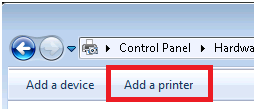
-
4. Click on Add a network, wireless or Bluetooth Printer
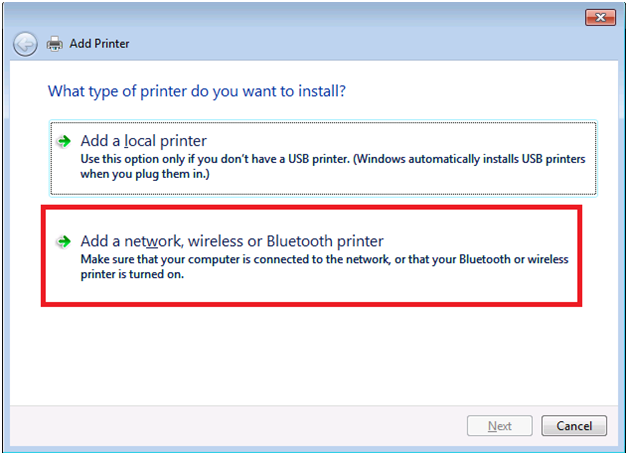
-
5. Click on The printer that I want isn't listed
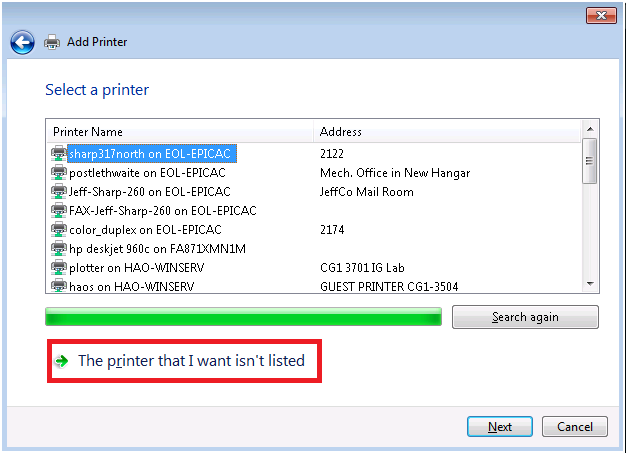
-
6. Select Add a printer using a TCP/IP address or hostname and click Next.
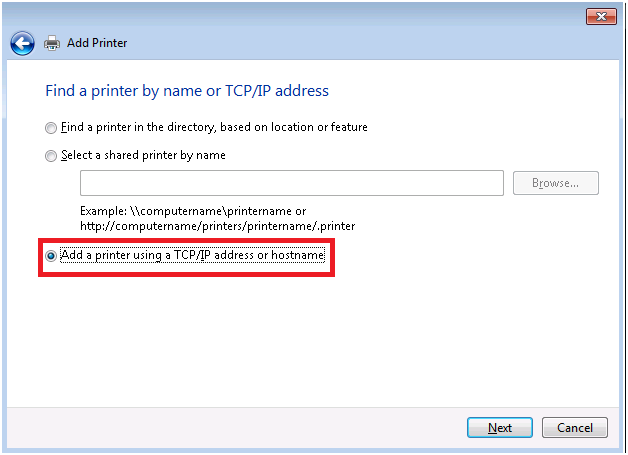
-
7. Type the printer name followed by .cgd.ucar.edu in the Hostname or IP address: box. Make sure there are not any spaces between printername and .cgd.ucar.edu. Click Next. Please see Printer Locations for printer names and locations
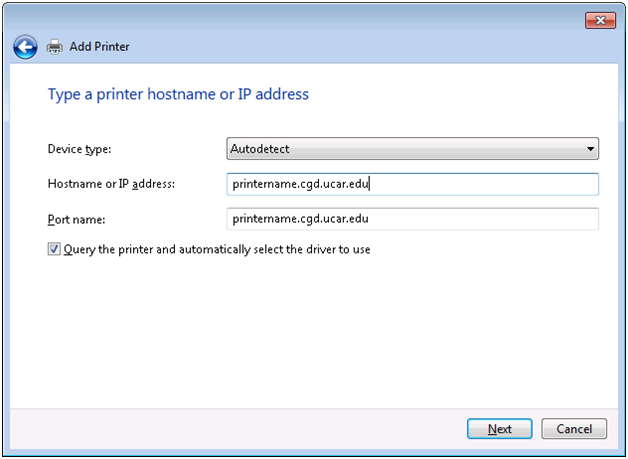
-
8. (Optional) Install the printer driver. Select HP under Manufacturer and HP Universal Printing PS under Printers.
Note: If the HP Universal Printing PS driver is not present on your system you can download it from here: ftp://ftp.hp.com/pub/softlib/software12/COL40842/ds-99376-4/upd-ps-x64-5.6.0.14430.exe
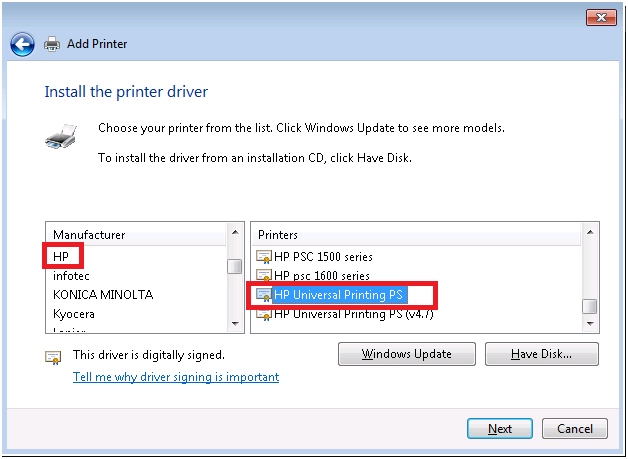
-
9. On the Type a printer name wizard type the printer name on the Printer name: line and click Next to complete the printer install
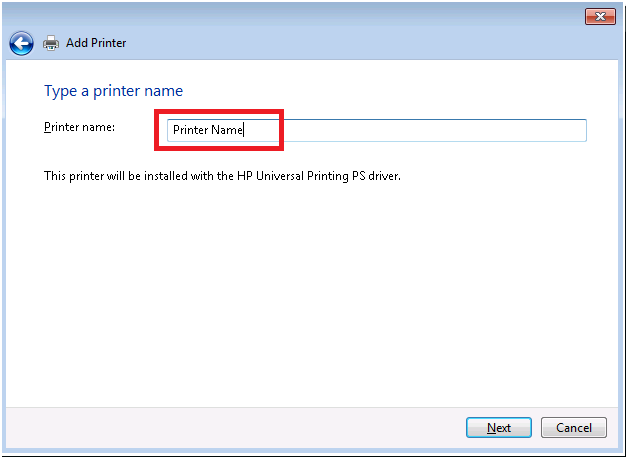
-
10. Click Do not share this printer and click Next.
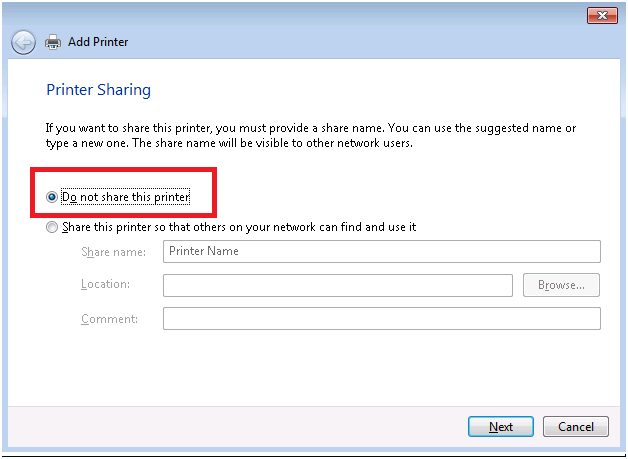
-
11. Click on Print a test page to test that the printer is installed correctly, and click Finish to complete the printer install.
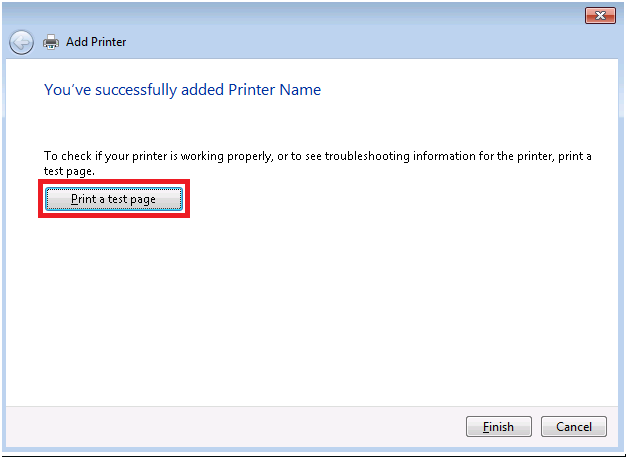

03 - Email
UCAR provides Gmail accounts for staff, postdocs, and long term collaborators that are on site. If you are visiting from another institution, we prefer that you use your e-mail account from your home institution.
UCAR has setup an internal help site for all things Google Apps. Quick starts, training videos and FAQs are all available here: Google Apps Support Site
03.01 - Email Address
All UCAR/NCAR e-mail addresses are of the form username@ucar.edu
Although e-mail sent to username@cgd.ucar.edu will automatically be delivered to the username@ucar.edu address, you should simply get in the habit of using the @ucar.edu address.